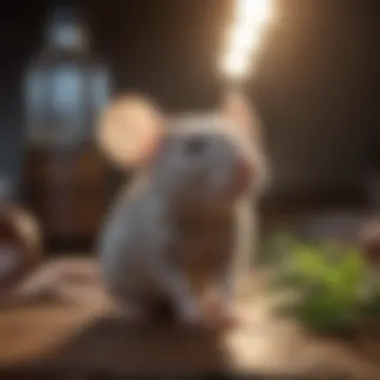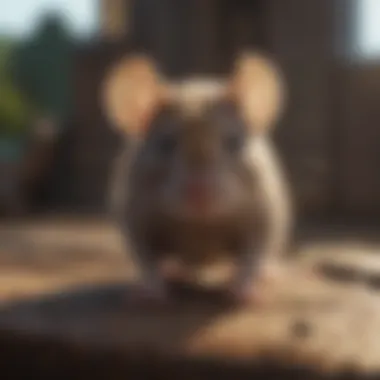Comprehensive Guide: Effective Methods to Repel Mice Successfully


Animal Species Profile
When combating mice infestations, understanding the animal species becomes pivotal. Mice, small rodents characterized by their pointed snouts, rounded ears, and scaly tails, are highly adaptable creatures found worldwide in various habitats, including urban, rural, and agricultural environments. Known for their nocturnal behavior and keen sense of smell, mice exhibit strong territorial tendencies and prolific breeding rates, making them challenging pests to control.
Preventive Measures
Implementing preventive strategies is key to deterring mice from invading your space. Begin by sealing all entry points, no matter how small, with steel wool or mesh to prevent mouse ingress. Keeping food stored in airtight containers and maintaining cleanliness to remove potential food sources are crucial steps in mouse prevention. Additionally, decluttering living areas and removing potential nesting materials like paper and fabrics can make your home less appealing to these rodents.
Natural Deterrents
Harnessing the power of natural deterrents can help repel mice effectively without resorting to harmful chemicals. Peppermint oil, known for its strong scent that mice find repugnant, can be used as a natural repellent by soaking cotton balls with the oil and placing them strategically around entry points. Other natural deterrents like mothballs, ammonia, and ultrasonic devices can also be effective in deterring mice through their potent odors or high-frequency sounds.
Humane Trapping Techniques
For those preferring to tackle mouse infestations humanely, trapping techniques offer a compassionate approach to dealing with these pests. Live traps, designed to capture mice unharmed, can be baited with peanut butter or seeds to attract the rodents, allowing for their safe removal and release in a more suitable environment. Check traps regularly and relocate captured mice far from your residence to prevent their return. Remember, humane trapping requires vigilance and patience but can successfully address mouse problems without causing harm.
Synthesis
Understanding Mouse Behavior
In this comprehensive guide focusing on effective methods to repel mice, understanding mouse behavior plays a crucial role. By delving into the intricacies of mouse behavior, readers gain valuable insights into the habits and tendencies of these rodents. This understanding can aid in developing strategic approaches to mouse control, whether dealing with current infestations or proactively preventing future problems. Analyzing mouse behavior offers a foundation for implementing methods that align with the natural instincts and patterns of these pests.
Characteristics of Mice
Physical Attributes
Exploring the physical attributes of mice sheds light on their appearance, size, and sensory capabilities. Understanding these characteristics is essential for identifying potential entry points in homes or structures where mice can gain access. The nimble bodies and keen sense of smell of mice enable them to navigate various environments with ease, making it crucial to address vulnerabilities in buildings to prevent infestations. Although small in size, mice possess remarkable agility and adaptability, allowing them to thrive in diverse settings. Leveraging knowledge about their physical attributes is key to developing effective pest control strategies.
Reproductive Patterns
Mouse reproductive patterns play a significant role in their population growth and breeding cycles. Female mice are prolific breeders, capable of producing multiple litters throughout the year. This rapid reproduction rate underscores the importance of prompt action when addressing mouse infestations to prevent exponential population growth. Awareness of their reproductive behavior guides efforts in implementing targeted control measures to disrupt breeding opportunities and mitigate infestations effectively. By addressing the reproductive patterns of mice, strategies can be tailored to reduce breeding success and curb population expansion.
Behavioral Tendencies
Understanding the behavioral tendencies of mice offers valuable insights into their foraging, nesting, and exploratory behaviors. Mice exhibit nocturnal activity, seeking food and shelter primarily during nighttime hours. Their keen sense of smell directs them towards potential food sources, making kitchens and pantries common areas of interest. By comprehending these behavioral traits, individuals can focus on securing food storage areas and implementing preventive measures to deter mice effectively. Awareness of their tendencies aids in predicting movement patterns and targeting areas of vulnerability, enhancing the overall efficacy of pest control efforts.
Common Habits of Mice
Feeding Patterns
Exploring the feeding patterns of mice unveils their preference for high-protein, high-calorie foods. This dietary inclination drives mice to seek out sources of grains, seeds, and sweets, making households with accessible food stores susceptible to infestations. By understanding their feeding habits, individuals can prioritize proper food storage practices and limit access to attractants that appeal to mice. Preventing easy access to food deters mice from establishing nests and reduces the likelihood of encounters within living spaces. Addressing feeding patterns effectively mitigates the risk of infestations and promotes a pest-free environment.
Nesting Behaviors
The nesting behaviors of mice involve creating nests in secluded, dark areas using materials like paper, fabric, and insulation. By recognizing these tendencies, individuals can identify potential nesting sites within homes and structures. Mice often build nests near a food source, emphasizing the importance of thoroughly inspecting areas where food is stored or prepared. Mitigating nesting opportunities by sealing off entry points and eliminating nesting materials reduces the likelihood of mice establishing territories indoors. Understanding their nesting behaviors informs preventative measures aimed at disrupting nest construction and minimizing habitat suitability for mice.


Movements and Territories
The movements and territories of mice revolve around establishing routes for navigation and defining areas for feeding and nesting. Mice exhibit exploratory behaviors, traversing paths that offer access to resources and shelter. By mapping out their movement patterns, individuals can identify common travel routes and potential entry points for mice. Understanding their territories assists in deploying traps and deterrents strategically to intercept mice along their typical pathways. By disrupting their movements and marking territories as inhospitable, individuals can effectively deter mice from inhabiting indoor spaces and reduce the likelihood of recurring infestations.
Preventive Measures to Deter Mice
Preventive measures to deter mice are crucial in maintaining a pest-free environment. By addressing potential entry points and eliminating attractants, you can effectively ward off rodents from infesting your space. The significance of these measures lies in their proactive nature, preventing costly infestations and safeguarding the health of occupants. Implementing preventive strategies not only ensures immediate relief from mice but also serves as a long-term solution to mitigate future rodent problems.
Sealing Entry Points
Inspecting for Gaps
Inspecting for gaps in your property's foundation, walls, and utility lines is a fundamental step in mouse-proofing your home. This meticulous assessment helps identify potential entry points that mice could exploit. By sealing these gaps with appropriate materials, such as steel wool or caulking, you create a barrier that deters rodents effectively. The key characteristic of inspecting for gaps is its proactive approach, addressing vulnerabilities before they lead to infestations. This attention to detail significantly reduces the likelihood of mice infiltrating your living spaces.
Using Sealants and Caulk
Utilizing sealants and caulk to fill in gaps and cracks is a cost-effective and efficient method to mouse-proof your property. The tight seal created by these materials inhibits mice from squeezing through tiny openings, denying them access to your home. The convenience of applying sealants and caulk makes them a popular choice for homeowners seeking quick solutions to bolster their defenses against rodents. While their ease of use is advantageous, proper application is key to maximizing their effectiveness in preventing mouse intrusion.
Reinforcing Doors and Windows
Reinforcing doors and windows plays a pivotal role in preventing mice from entering your home. Ensuring that entry points are secure and properly sealed helps fortify your property against rodent incursions. By installing door sweeps, repairing damaged screens, and fixing gaps around windows, you create a barrier that diminishes the opportunities for mice to invade. The unique feature of reinforcing doors and windows is its tangible impact on deterring rodents indoors, emphasizing the importance of structural integrity in warding off pests. While reinforcing entryways is an effective strategy, periodic maintenance and inspection are necessary to sustain the protective barrier over time.
Maintaining Cleanliness
Proper Food Storage
Properly storing food items in airtight containers is a simple yet essential practice in mouse prevention. By denying access to readily available food sources, you eliminate one of the primary motivators for mice to inhabit your premises. The key characteristic of proper food storage is its proactive nature, removing temptations that could attract rodents. This method not only minimizes the risk of infestation but also promotes overall hygiene and food safety in the household.
Regular Cleaning Practices
Regular cleaning routines are instrumental in deterring mice by removing potential nesting materials and food residues. Maintaining a clutter-free environment and regularly sanitizing surfaces diminishes the appeal of your home to rodents. The key characteristic of regular cleaning practices is their preventive nature, disrupting the living conditions favorable to mice. Consistent cleaning not only enhances the visual appeal of your living space but also serves as a proactive measure in keeping rodents at bay.
Clutter Reduction
Reducing clutter in and around your property is essential for minimizing potential hiding spots and nesting areas for mice. Decluttering storage spaces, garages, and outdoor areas reduces the available shelter for rodents and limits their ability to establish themselves. The unique feature of clutter reduction is its impact on removing obstacles that allow mice to thrive undetected. While decluttering requires initial effort, maintaining an organized environment offers long-term benefits in deterring rodent activity and facilitating effective pest control measures.
Eliminating Food Sources
Securing Trash Bins
Securing trash bins with tight-fitting lids and regularly disposing of garbage reduces food accessibility for mice. By eliminating this food source, you discourage rodents from foraging near your property and seeking shelter indoors. The key characteristic of securing trash bins is its immediate impact on reducing attractants that lure mice into your vicinity. Proper waste management practices not only enhance pest prevention efforts but also contribute to a cleaner and more hygienic living environment.
Removing Pet Food
Removing pet food after feeding times prevents mice from scavenging leftovers and becoming regular visitors to your space. Securing pet food in sealed containers or indoors prevents it from attracting rodents and other pests. The unique feature of removing pet food is its focus on specific attractants that can habituate mice to frequent your property. By practicing strict food disposal routines, you minimize the likelihood of encouraging rodent activity around your home.


Managing Bird Feeders
Managing bird feeders to minimize spillage and placing them away from buildings helps prevent unintended food sources for mice. Birds' leftovers can attract rodents, leading to potential infestations near your residence. The key characteristic of managing bird feeders is its indirect impact on reducing food availability for mice. By strategically situating bird feeders and promptly cleaning up any scattered feed, you limit opportunities for rodents to scavenge and establish themselves in close proximity. This proactive approach not only safeguards bird welfare but also aids in pest management by denying mice access to supplementary food sources.
Natural Deterrents for Mouse Control
In this article, the focus shifts towards the significance of natural deterrents for mouse control. As we delve into this topic, it is crucial to understand the specific elements that make natural deterrents a promising solution. Unlike chemical-based repellents, natural options provide a safer and environmentally friendly approach to managing mouse infestations. By exploring natural deterrents, readers can discover a holistic way to address rodent issues while minimizing potential harm to pets, wildlife, and the ecosystem.
Essential Oils and Plants
Peppermint Oil
Delving into peppermint oil, we uncover a key player in the realm of natural pest control. The distinct aroma of peppermint oil serves as a powerful repellent against mice, disrupting their ability to navigate spaces effectively. This characteristic makes peppermint oil a preferred choice for deterring rodents without resorting to toxic substances. Its natural properties allow for effective mouse control while maintaining a safer environment for inhabitants and pets. The unique feature of peppermint oil lies in its ability to mask familiar odors that would typically attract rodents, thus creating an inhospitable environment for mice within homes or establishments.
Eucalyptus
Transitioning to eucalyptus, we encounter another potent component in the arsenal of natural deterrents. Eucalyptus is renowned for its strong scent that repels rodents effectively. This characteristic makes it a popular choice for those seeking a natural and holistic approach to pest management. The unique feature of eucalyptus lies in its ability to create a barrier that rodents find unappealing, steering them away from infested areas effortlessly. By incorporating eucalyptus as a repellent, individuals can deter mice while embracing an eco-friendly solution that aligns with sustainable pest control practices.
Lavender
Exploring lavender as a natural repellent introduces a fragrant and aesthetically pleasing option for mouse control. The key characteristic of lavender lies in its soothing aroma, which not only enhances living spaces but also deters unwanted rodent intrusions. This beneficial aspect makes lavender a pleasant choice for individuals aiming to repel mice without compromising on sensory experiences. The unique feature of lavender stems from its dual functionality, serving as both a visually appealing plant and a practical deterrent against rodents. By utilizing lavender as a natural repellent, individuals can achieve a harmonious balance between pest control and environmental enhancements.
Home Remedies and Repellents
Baking Soda
When considering baking soda as a home remedy for repelling mice, its multifaceted contributions come to light. Baking soda's alkaline nature poses as a deterrent for rodents due to its abrasive texture, causing discomfort upon contact. This key characteristic makes baking soda a favorable choice for individuals seeking non-toxic yet effective solutions for pest control. The unique feature of baking soda resides in its versatility, enabling it to be used in various forms to target specific areas where mice are likely to roam. By leveraging baking soda as a repellent, individuals can manage mouse infestations seamlessly while promoting a safer living environment for all occupants.
Steel Wool
Exploring the usage of steel wool as a deterrent sheds light on its practical significance in pest management. Steel wool's abrasive texture acts as a physical barrier that deters rodents from accessing entry points or nesting areas. This key characteristic makes steel wool a popular choice for blocking off potential rodent pathways without resorting to chemical interventions. The unique feature of steel wool lies in its durability and long-lasting effectiveness, providing a reliable solution for individuals aiming to prevent mouse intrusions sustainably. By incorporating steel wool as a repellent, individuals can fortify their living spaces against rodent infestations while maintaining structural integrity and safety.
Ammonia
When considering ammonia as a repellent against mice, its potent properties reveal a robust deterrent for rodents. The strong scent of ammonia disrupts the sensory receptors of mice, deterring them from inhabiting treated areas effectively. This key characteristic makes ammonia a formidable choice for individuals seeking immediate and potent solutions for rodent control. The unique feature of ammonia lies in its rapid action and efficacy in repelling mice from designated spaces. By utilizing ammonia as a repellent, individuals can address mouse infestations promptly while minimizing potential risks associated with chemical-based alternatives.
Humane Trapping Methods
Humane trapping methods play a crucial role in this comprehensive guide on repelling mice effectively. By embracing humane practices, we uphold ethical standards while managing rodent infestations. These methods prioritize the safe capture and release of mice without causing harm or distress. As responsible individuals seeking to maintain a balance between nature and human habitation, opting for humane trapping methods aligns with sustainable pest management practices. By focusing on empathy and respect for all living beings, readers can effectively address mouse issues without resorting to inhumane or harmful extermination techniques.
Live Mouse Traps
Types of Live Traps
Live mouse traps are a cornerstone of humane trapping methods, offering a non-lethal approach to rodent control. These traps are designed to capture mice alive, allowing for their safe relocation away from domestic spaces. The key characteristic of live traps lies in their ability to hold mice without causing them harm, presenting an ethical and practical solution for pest management. One of the main advantages of using live traps in this article is their efficiency in capturing rodents without the need for toxic baits or chemicals. However, a potential disadvantage of live traps can be the need for frequent monitoring to ensure timely relocation of captured mice to prevent stress or harm.


Placement Tips
Effective placement of live traps is vital for successful rodent capture in this repelling guide. Proper positioning of traps in areas with high mouse activity increases the likelihood of catching target pests. The key characteristic of strategic trap placement is the emphasis on identifying mouse pathways and nesting spots to maximize trapping efficiency. By placing traps along walls, near entry points, and in concealed spaces, readers can optimize their trapping efforts and enhance their overall success rate. Placement tips act as a valuable asset in this article, offering practical guidance for achieving desirable outcomes in mice repulsion.
Bait Selection
Choosing suitable bait for live traps is a critical aspect of this comprehensive guide on mouse control. The selection of bait influences the trap's effectiveness in attracting mice and increasing capture rates. The key characteristic of bait selection is tailoring the bait to match mice's dietary preferences, such as peanut butter or cheese, to entice them into the trap. Utilizing appealing and fragrant baits enhances trap performance, making it a popular choice for effectively luring rodents. While bait selection significantly contributes to successful trapping in this article, potential disadvantages may include the need to regularly replenish bait to maintain trap allure and efficiency.
Release and Prevention
Safe Release Practices
After capturing mice using humane trapping methods, safe release practices are essential to maintaining ethical pest management standards in this guide. Safely releasing mice in suitable habitats far from human settlements decreases the likelihood of reinfestation and allows rodents to thrive without posing risks to human dwellings. The key characteristic of safe release practices is the emphasis on selecting appropriate release sites that offer mice ample resources and shelter for survival. By integrating safe release practices, readers can contribute to ecosystem preservation while protecting their homes from rodent intrusions.
Sealing Entry Points After Capture
Sealing entry points after capturing mice is a fundamental step in preventing future infestations outlined in this repelling guide. Blocking potential entryways that mice exploited ensures that new rodents cannot infiltrate homes or buildings. The key characteristic of sealing entry points after capture is the proactive approach it takes in fortifying structures against rodent ingress, limiting opportunities for subsequent infestations. Readers benefit from this strategy by creating a barrier that deters mice from re-entering once released, enhancing long-term rodent prevention effectively. However, a potential disadvantage of this method may be the time and effort required to identify and seal all access points thoroughly.
Follow-up Monitoring
Sustaining pest control efforts involves vigilant follow-up monitoring post-mouse capture, an integral part of this exhaustive guide on repelling mice. Continued surveillance aids in assessing the effectiveness of implemented control measures and identifying any recurring rodent activity. The key characteristic of follow-up monitoring lies in its role in gauging the success of pest management strategies, allowing for adjustments or reinforcements as needed. By practicing regular follow-up monitoring as elucidated in this article, readers can proactively address any potential reinfestation threats, ensuring long-lasting protection against mice in their environments.
Professional Pest Control Options
Professional pest control options play a crucial role in maintaining a pest-free environment. When preventive measures and DIY methods fall short, seeking professional help becomes imperative. Pest control services bring expertise and specialized tools to address persistent infestations effectively. They are equipped to handle complex structures where mice may hide and breed unnoticed. Additionally, professionals understand the health concerns associated with mice infestations, promoting safe and efficient extermination practices. By choosing professional pest control, individuals can benefit from in-depth inspections, tailored solutions, and long-term prevention strategies.
When to Seek Professional Help
Persistent Infestations
Persistent infestations pose a significant challenge, indicating a severe mouse problem that requires immediate attention. These infestations persist despite individual efforts, suggesting a deep-rooted issue that only professionals can effectively tackle. The key characteristic of persistent infestations is their resilience, often reoccurring despite temporary solutions. While challenging, they present an opportunity to address underlying factors contributing to the infestation, ensuring long-lasting results. Despite the drawbacks of persistent infestations, they serve as a beneficial trigger to engage professional pest control services, safeguarding homes from prolonged rodent presence.
Complex Structures
Mice can infiltrate intricate structures within a property, making conventional eradication methods ineffective. Complex structures provide numerous hiding spots for mice, complicating extermination procedures. Professionals excel in navigating these intricate spaces, utilizing specialized equipment and techniques to locate and eliminate mice effectively. The unique feature of addressing complex structures lies in the precision required to reach inaccessible areas where mice may dwell. While challenging, tackling complex structures ensures comprehensive treatment, preventing future re-infestations and promoting long-term pest control.
Health Concerns
Health concerns related to mice infestations underscore the importance of prompt and thorough pest control measures. Mice carry diseases, contaminate food sources, and compromise indoor air quality, posing health risks to occupants. By addressing health concerns promptly, pest control services protect individuals from potential illnesses and allergic reactions linked to mouse presence. The unique feature of considering health concerns is the emphasis on creating a safe and hygienic living environment through targeted pest control interventions. While demanding, prioritizing health concerns in pest control strategies enhances overall well-being and ensures a pest-free premise.
Choosing a Pest Control Service
Credentials and Experience
The credentials and experience of pest control services are vital criteria for selecting the right provider. Established credentials indicate a high level of professionalism and adherence to industry standards. Experienced professionals possess in-depth knowledge of mouse behavior and effective control methods, ensuring comprehensive solutions tailored to individual needs. The key characteristic of credentials and experience lies in the reliability and competence of the service provider, instilling confidence in their ability to resolve pest issues efficiently. While advantageous, considering credentials and experience aids in making informed decisions and securing reliable pest control services.
Integrated Pest Management
Integrated pest management (IPM) approaches offer eco-friendly and sustainable solutions for pest control. IPM focuses on prevention, monitoring, and control to minimize environmental impact while effectively managing pests. This approach emphasizes non-chemical methods alongside targeted pesticide use, promoting long-term pest prevention without compromising safety. The unique feature of IPM is its holistic and proactive nature, emphasizing habitat modification and preventive measures to deter pests. Despite challenges, embracing integrated pest management ensures environmentally conscious pest control practices and promotes overall ecosystem health.
Follow-up Procedures
Establishing comprehensive follow-up procedures is essential for evaluating the effectiveness of pest control measures and preventing future infestations. Follow-up inspections allow professionals to monitor pest activity post-treatment, ensuring eradication success and addressing any residual concerns. The key characteristic of follow-up procedures is the continuity of pest control efforts, promoting sustained protection against mice and other pests. Implementing thorough follow-up protocols aids in identifying any re-infestation risks and implementing corrective actions promptly. While demanding, integrating follow-up procedures into pest control strategies guarantees long-term efficacy and continuous pest management.







